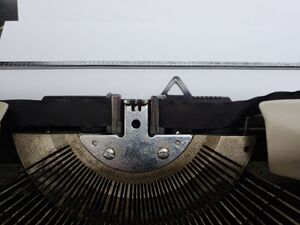Difference between revisions of "Kong Byung-Woo Typewriter"
m |
|||
| Line 5: | Line 5: | ||
[[File:Dual Type Guide.jpeg|thumb]] | [[File:Dual Type Guide.jpeg|thumb]] | ||
| − | + | These typewriters have two type guides, while most of the common typewriters have only one. Among with the two guides arranged side by side, typebars for consonant, vowel, and some symbols are aligned for the right one. Their keys also moves the cursor forward, so syllables composed with consonant and vowel occupy two units of the character width. | |
| − | Meanwhile, | + | Meanwhile, only typebars with Hangul 'final consonant' on it are aligned to fit in the left guide. They print their letters(final consonants) one unit left without advancing the cursor. This results in a complete syllable with consonant, vowel, and the optional final consonant, printed in place together, still occupying two units of width. |
== History == | == History == | ||
Revision as of 16:01, 17 June 2022
The Kong Byung-Woo Typewriter, also known as 3-Set Hangul Typewriter, is the first of Hangul Typewriters to implement Syllable-based Hangul writing system along with LTR Horizontal writing.
Basic Info
These typewriters have two type guides, while most of the common typewriters have only one. Among with the two guides arranged side by side, typebars for consonant, vowel, and some symbols are aligned for the right one. Their keys also moves the cursor forward, so syllables composed with consonant and vowel occupy two units of the character width.
Meanwhile, only typebars with Hangul 'final consonant' on it are aligned to fit in the left guide. They print their letters(final consonants) one unit left without advancing the cursor. This results in a complete syllable with consonant, vowel, and the optional final consonant, printed in place together, still occupying two units of width.
